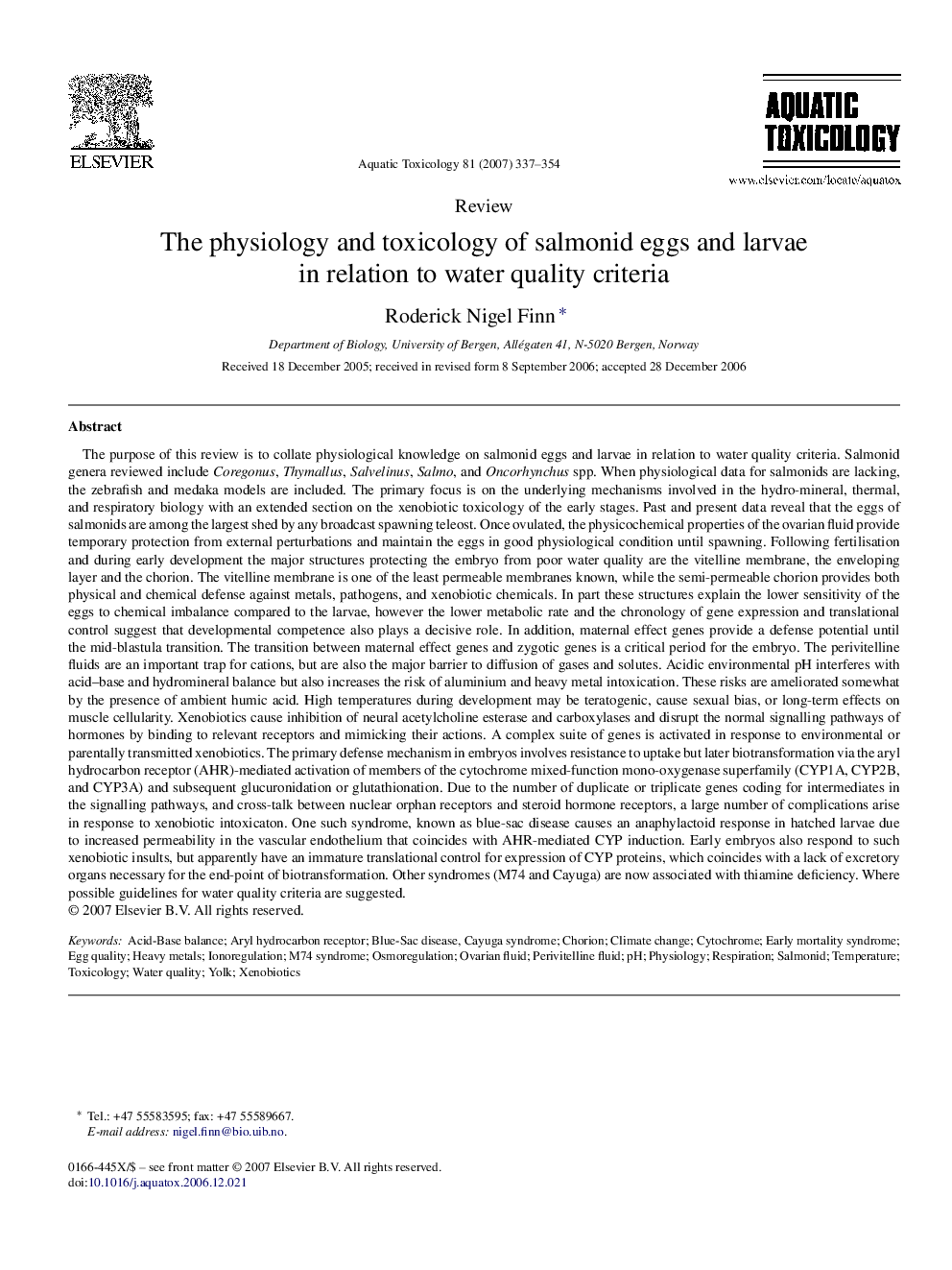| کد مقاله | کد نشریه | سال انتشار | مقاله انگلیسی | نسخه تمام متن |
|---|---|---|---|---|
| 4531180 | 1324759 | 2007 | 18 صفحه PDF | دانلود رایگان |

The purpose of this review is to collate physiological knowledge on salmonid eggs and larvae in relation to water quality criteria. Salmonid genera reviewed include Coregonus, Thymallus, Salvelinus, Salmo, and Oncorhynchus spp. When physiological data for salmonids are lacking, the zebrafish and medaka models are included. The primary focus is on the underlying mechanisms involved in the hydro-mineral, thermal, and respiratory biology with an extended section on the xenobiotic toxicology of the early stages. Past and present data reveal that the eggs of salmonids are among the largest shed by any broadcast spawning teleost. Once ovulated, the physicochemical properties of the ovarian fluid provide temporary protection from external perturbations and maintain the eggs in good physiological condition until spawning. Following fertilisation and during early development the major structures protecting the embryo from poor water quality are the vitelline membrane, the enveloping layer and the chorion. The vitelline membrane is one of the least permeable membranes known, while the semi-permeable chorion provides both physical and chemical defense against metals, pathogens, and xenobiotic chemicals. In part these structures explain the lower sensitivity of the eggs to chemical imbalance compared to the larvae, however the lower metabolic rate and the chronology of gene expression and translational control suggest that developmental competence also plays a decisive role. In addition, maternal effect genes provide a defense potential until the mid-blastula transition. The transition between maternal effect genes and zygotic genes is a critical period for the embryo. The perivitelline fluids are an important trap for cations, but are also the major barrier to diffusion of gases and solutes. Acidic environmental pH interferes with acid–base and hydromineral balance but also increases the risk of aluminium and heavy metal intoxication. These risks are ameliorated somewhat by the presence of ambient humic acid. High temperatures during development may be teratogenic, cause sexual bias, or long-term effects on muscle cellularity. Xenobiotics cause inhibition of neural acetylcholine esterase and carboxylases and disrupt the normal signalling pathways of hormones by binding to relevant receptors and mimicking their actions. A complex suite of genes is activated in response to environmental or parentally transmitted xenobiotics. The primary defense mechanism in embryos involves resistance to uptake but later biotransformation via the aryl hydrocarbon receptor (AHR)-mediated activation of members of the cytochrome mixed-function mono-oxygenase superfamily (CYP1A, CYP2B, and CYP3A) and subsequent glucuronidation or glutathionation. Due to the number of duplicate or triplicate genes coding for intermediates in the signalling pathways, and cross-talk between nuclear orphan receptors and steroid hormone receptors, a large number of complications arise in response to xenobiotic intoxicaton. One such syndrome, known as blue-sac disease causes an anaphylactoid response in hatched larvae due to increased permeability in the vascular endothelium that coincides with AHR-mediated CYP induction. Early embryos also respond to such xenobiotic insults, but apparently have an immature translational control for expression of CYP proteins, which coincides with a lack of excretory organs necessary for the end-point of biotransformation. Other syndromes (M74 and Cayuga) are now associated with thiamine deficiency. Where possible guidelines for water quality criteria are suggested.
Journal: Aquatic Toxicology - Volume 81, Issue 4, 30 March 2007, Pages 337–354